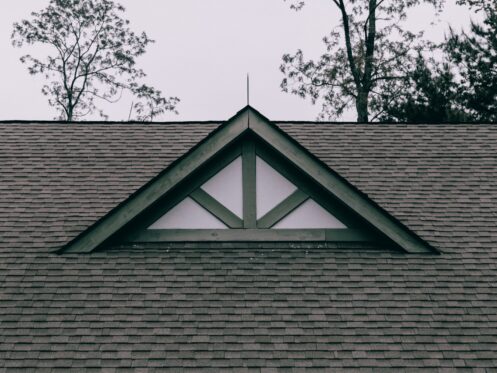The roof on your San Antonio, TX home is a many-layered system that creates a durable, watertight barrier against the natural elements. Each roofing component plays an important role in keeping moisture out. Even minor roofing damage can provide viable points of ingress. Thus, although some roof leaks are conspicuous and easy to detect, others are much less so. To help you catch and correct these problems before they spiral out of control, the following are 10 signs that it’s time to schedule roof leak repairs.
1. Rusty or Blocked Gutters
Not all roof leaks affect building interiors. If your gutters are blocked, they’ll eventually overflow with runoff. Rather than directing runoff into downspouts and away from the building’s foundation, blocked gutters can leave your siding and your home’s perimeter saturated. Blocked gutters can also cause water to saturate the roof’s sheathing, which will eventually lead to curled or missing shingles and “popped,” or protruding, nails. The good news is that you can solve this problem and prevent further property damage by simply cleaning your gutters out.
Rusty gutters or gutters that are riddled with corrosion often have large holes and fast-spreading weak spots. Water continually seeps through these holes and may pool near your home’s foundation and leave your siding discolored.
The average lifespan of gutters is different for each gutter material. Galvanized steel gutters last about 15 years. If well-maintained, aluminum gutters can last three full decades, and zinc gutters often last up to 50 years. If your gutters are nearing the end of their lifespan and have visible rust, now is the perfect time to replace them.
2. A Soft, Saggy Ceiling
It may be that water has been entering your home for quite some time and is only now making itself apparent. If your ceiling looks slightly misshapen or has started to sag, there’s likely a pool of rainwater just overhead. You may be able to identify the location of a ceiling leak by checking your attic for pooling water.
To prevent further building damage, schedule roof leak repairs as soon as possible. While waiting for roofers to arrive, move any furnishings and valuables that are just beneath the affected area and keep pets and people away.
3. Water Spots On Walls and Ceilings
It’s easy to assume that water spots on ceilings and walls mark the exact location of leaks. People often discover these blemishes and presume that the related roofing problems lie directly overhead. While this is sometimes the case, water can travel quite a distance after entering homes, and it often collects and pools in various areas along the way. The best way to locate the source of roof leaks that have already entered the building interior is by hiring a roofer. Other tell-tale signs of ceiling leaks include:
- Blistered or peeling paint
- Peeling wallpaper
- Dripping noises in the attic
- Bulging drywall
Unfortunately, ceiling leaks don’t always develop in noticeable, high-traffic locations. You might find these and other signs of a ceiling leak in your pantry, closet, or laundry room.
4. Discolored or Rotting Siding Panels
While gutter corrosion can leave your siding with long, red-brown streaks, roof leaks in other areas can cause discoloration, too. If you have a roof leak that sends water cascading down the sides of your home’s exterior walls, you might have warped or bulging siding, rotten or visibly eroded signing panels, and signs of water damage at the interior of the wall. This may be the case if there is structural damage at your eaves, blocked roof vents, or loose and missing shingles at the roof’s outer edge.
5. Attic “Shiners”
When checking your attic for pooling water or other evidence of leaks, look for “shiners,” or nails that aren’t embedded in framing members. While these nails don’t let outside moisture in, they’re regularly coated in condensation as warm air moves into the attic from downstairs areas. While the minute amounts of condensation that collect here might not seem like much, over time, they can lead to soft wood and odorous patches of mildew and mold. This becomes all the more problematic when attics have multiple shiners.
6. Missing and Damaged Roof Shingles
Missing and damaged shingles are among the most obvious signs of existing or potential roof leaks. You may be able to spot missing shingles by peering up at your roof from the curb, but if you already have moisture problems indoors, it’s best to schedule a professional roofing inspection. Although some homeowners can easily replace one or two missing shingles on their own, if you have more shingles missing or if there’s evidence of widespread or impact-related shingle damage, it’s best to place this job in the hands of experienced roofing professionals.
7. Missing Nails and Unsealed Nail Holes
For roofs to function as watertight systems, all of their nails must be firmly embedded and all nail holes should be properly sealed. If your roof is covered in “popped” nails, or if your roofer neglected to apply nail seals, each opening is a viable point of ingress for moisture. These issues can also set the stage for progressive shingle problems like lifting, curling, and loss.
8. Bent or Torn Flashing
Roof flashing is a thin layer of galvanized steel, copper, or aluminum that’s used in especially vulnerable areas like valleys and protrusions. For instance, your roof has flashing around all skylights, vents, and chimneys. It also has it just where two sections of roofing meet. If any of your roof’s flashing is bent or torn by wind, heavy precipitation, or falling debris, you might notice:
- Darkened shingles throughout the area
- Visible dents or cracks throughout the flashing itself
- Moldy or discolored fascia
- Localized problems with insects
Woodpeckers, squirrels, and other rooftop pests often create small holes in flashing. Be on the lookout for these, too. Rust and corrosion also undermine the integrity of flashing and may lead to roof leaks in areas that have it.
9. Soft, Squishy Roofing
When you suspect a roof leak, you might be tempted to get your ladder out and search for the problem yourself. However, homeowners are advised against mounting and walking across their roofs. You can apply light pressure to the outer edge of your roof with your palm to check for signs of wood rot. If your roof feels soft, squishy, or springy when pressure is applied, you need the help of a licensed roofing company right away.
10. Mold and Mildew
Roof leaks often lead to moldy, mildew-covered attics. However, having mold in other areas of your home can also be a sign of hidden roof leaks. Finding mold in your crawlspaces, closets, pantry, or wall corners is a good reason to check your roof’s integrity. The first step in successful mold mitigation is always finding the source of excess indoor moisture. After all, mold spores don’t generally flourish in environments with less than 60% humidity.
If you’ve already scheduled a whole-house plumbing inspection and have cleaned your bathroom exhaust fans and dryer vent, the most likely cause of excess moisture is your roof. Your roof may be depositing moisture in areas that you can’t see. By scheduling roof repair services, you can ensure the efficacy of your mold treatment.
We’ve been proudly serving San Antonio, TX since 1946. We offer outstanding roof replacement, maintenance, and repair services. We also provide new windows, insulation, siding, and entry door systems. If you have a leaky roof, give BELDON Roofing Company a call today!

